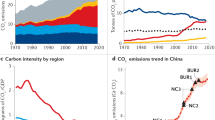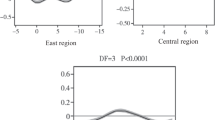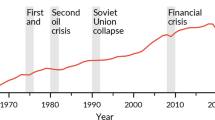Abstract
Global emissions of carbon dioxide (CO2) from fossil fuels and industry increased by 2.2% per year on average between 2005 and 20151. Global emissions need to peak and decline rapidly to limit climate change to well below 2 °C of warming2,3, which is one of the goals of the Paris Agreement4. Untangling the reasons underlying recent changes in emissions trajectories is critical to guide efforts to attain those goals. Here we analyse the drivers of decreasing CO2 emissions in a group of 18 developed economies that have decarbonized over the period 2005–2015. We show that within this group, the displacement of fossil fuels by renewable energy and decreases in energy use explain decreasing CO2 emissions. However, the decrease in energy use can be explained at least in part by a lower growth in gross domestic product. Correlation analysis suggests that policies on renewable energy are supporting emissions reductions and displacing fossil fuels in these 18 countries, but not elsewhere, and that policies on energy efficiency are supporting lower energy use in these 18 countries, as well as more widely. Overall, the evidence shows that efforts to reduce emissions are underway in many countries, but these efforts need to be maintained and enhanced by more stringent policy actions to support a global peak in emissions followed by global emissions reductions in line with the goals of the Paris Agreement3.
This is a preview of subscription content, access via your institution
Access options
Access Nature and 54 other Nature Portfolio journals
Get Nature+, our best-value online-access subscription
$29.99 / 30 days
cancel any time
Subscribe to this journal
Receive 12 print issues and online access
$209.00 per year
only $17.42 per issue
Buy this article
- Purchase on Springer Link
- Instant access to full article PDF
Prices may be subject to local taxes which are calculated during checkout



Similar content being viewed by others
Data availability
Energy data from the World Energy Balances, CO2 emissions from fuel combustion, and GDP data from the International Energy Agency are available at: https://www.iea.org/statistics. CO2 emissions based on consumption and from UNFCCC are available at https://www.icos-cp.eu/GCP/2018 (latest available version). CO2 emissions from BP Statistical Review of World Energy June 2017 are available at: https://www.bp.com/en/global/corporate/energy-economics/statistical-review-of-world-energy.html. Policy data from the IEA/IRENA Joint Policies and Measures are available at: https://www.iea.org/policiesandmeasures/renewableenergy/.
References
Le Quéré, C. et al. Global carbon budget 2017. Earth Syst. Sci. Data 10, 405–448 (2018).
IPCC Climate Change 2013: The Physical Science Basis (eds Stocker, T. F. et al.) (Cambridge Univ. Press, 2013).
van Vuuren, D. P. et al. Carbon budgets and energy transition pathways.Environ. Res. Lett. 11, 075002 (2016).
Jordan, A. et al. Going beyond two degrees? The risks and opportunities of alternative options. Clim. Policy 13, 751–769 (2013).
IPCC Climate Change 2014: Synthesis Report (eds Core Writing Team, Pachauri, R. K. & Meyer, L. A.) (IPCC, 2014).
Boden, T. A., Marland, G. & Andres, R. J. Global, Regional, and National Fossil-Fuel CO 2 Emissions (Oak Ridge National Laboratory, US Department of Energy, 2017); http://cdiac.ornl.gov/trends/emis/overview_2014.html
Peters, G. P., Minx, J. C., Weber, C. L. & Edenhofer, O. Growth in emission transfers via international trade from 1990 to 2008. Proc. Natl Acad. Sci. USA 108, 8903–8908 (2011).
Davis, S. J. & Caldeira, K. Consumption-based accounting of CO2 emissions. Proc. Natl Acad. Sci. USA 107, 5687–5692 (2010).
Peters, G. P. et al. Key indicators to track current progress and future ambition of the Paris Agreement. Nat. Clim. Change 7, 118–123 (2017).
Fankhauser, S., Gennaioli, C. & Collins, M. Do international factors influence the passage of climate change legislation?. Clim. Policy 16, 318–331 (2015).
Bernauer, T. & Böhmelt, T. National climate policies in international comparison: the climate change cooperation index. Environ. Sci. Policy 25, 196–206 (2013).
Dubash, N. K., Hagemann, M., Höhne, N. & Upadhyaya, P. Developments in national climate change mitigation legislation and strategy. Clim. Policy 13, 649–664 (2013).
Lachapelle, E. & Paterson, M. Drivers of national climate policy. Clim. Policy 13, 547–571 (2013).
Riahi, K. et al. Locked into Copenhagen pledges—implications of short-term emission targets for the cost and feasibility of long-term climate goals. Technol. Forecast. Soc. Change 90, 8–23 (2015).
van Vuuren, D. P. et al. Alternative pathways to the 1.5 °C target reduce the need for negative emission technologies. Nat. Clim. Change 8, 391–397 (2018).
van Vuuren, D. P. et al. What do near-term observations tell us about long-term developments in greenhouse gas emissions? A letter. Climatic Change 103, 635–642 (2010).
Marcinkiewicz, K. & Tosun, J. Contesting climate change: mapping the political debate in Poland. East Eur. Polit. 31, 187–207 (2015).
Tosun, J. Environmental monitoring and enforcement in Europe: a review of empirical research. Environ. Policy Gov. 22, 437–448 (2012).
Dietz, T., Frank, K. A., Whitley, C. T., Kelly, J. & Kelly, R. Political influences on greenhouse gas emissions from US states. Proc. Natl Acad. Sci. USA 112, 8254–8259 (2015).
Knill, C., Schulze, K. & Tosun, J. Regulatory policy outputs and impacts: exploring a complex relationship. Regul. Gov. 6, 427–444 (2012).
Girod, B., van Vuuren, D. P. & Hertwich, E. G. Climate policy through changing consumption choices: options and obstacles for reducing greenhouse gas emissions. Glob. Environ. Change 25, 5–15 (2014).
Grubler, A. et al. A low energy demand scenario for meeting the 1.5 °C target and sustainable development goals without negative emission technologies. Nat. Energy 3, 515–527 (2018).
Wilson, C., Grubler, A., Gallagher, K. S. & Nemet, G. F. Marginalization of end-use technologies in energy innovation for climate protection. Nat. Clim. Change 2, 780–788 (2012).
Le Quéré, C. et al. Global carbon budget 2018. Earth Syst. Sci. Data 10, 2141–2194 (2018).
Masson-Delmotte, V. et al. (eds) Global Warming of 1.5 °C (IPCC, WMO, 2018).
Figueres, C., Whiteman, G., Le Quéré, C. & Peters, G. P. Carbon emissions rise again. Nature 564, 27–30 (2018).
World Energy Balances (IEA, OECD, accessed July 2018).
CO 2 Emissions from Fuel Combustion (IEA, OECD, accessed 2017).
Le Quéré, C. et al. Global carbon budget 2016. Earth Syst. Sci. Data 8, 605–649 (2016).
Joint Policies and Measures (International Energy Agency, International Renewable Energy Agency, accessed 1 May 2018).
Ang, B. W. The LMDI approach to decomposition analysis: a practical guide. Energy Policy 33, 867–871 (2005).
Acknowledgements
C.L.Q., C.W., G.P.P. and D.P.v.V. received funding from the UK Department for Business, Energy & Industrial Strategy, as part of the ‘Implications of global warming of 1.5 °C and 2 °C' project. A.J. and J.T. were supported by the European Commission COST Action IS1309 (INOGOV). C.L.Q. and C.W. also received funding from the European Commission, respectively from grant no. 776810 for the VERIFY project and from ERC Starting Grant no. 678799 for the SILCI project. We thank L. Leopold for assistance with the policy data. We thank the IEA for providing access to it’s data.
Author information
Authors and Affiliations
Contributions
C.L.Q., G.P.P. and J.G.C. conceived the project. C.L.Q., J.I.K., G.P.P., C.W., R.A. and R.J.A. designed and produced the analysis of the energy and CO2 data. J.T. and A.J. designed and produced the analysis of the policy data. D.P.v.V. and C.W. provided and analysed the IAM data. All authors contributed to the interpretation of the results and wrote the paper.
Corresponding author
Ethics declarations
Competing interests
The authors declare no competing interests.
Additional information
Journal peer review information Nature Climate Change thanks Christopher Green and the other anonymous reviewer(s) for their contribution to the peer review of this work.
Publisher’s note: Springer Nature remains neutral with regard to jurisdictional claims in published maps and institutional affiliations.
Supplementary information
Supplementary Information
Supplementary Tables 1–6, Supplementary Figures 1–4, Supplementary References
Rights and permissions
About this article
Cite this article
Le Quéré, C., Korsbakken, J.I., Wilson, C. et al. Drivers of declining CO2 emissions in 18 developed economies. Nat. Clim. Chang. 9, 213–217 (2019). https://doi.org/10.1038/s41558-019-0419-7
Received:
Accepted:
Published:
Issue Date:
DOI: https://doi.org/10.1038/s41558-019-0419-7
This article is cited by
-
A unified modelling framework for projecting sectoral greenhouse gas emissions
Communications Earth & Environment (2024)
-
Socio-political feasibility of coal power phase-out and its role in mitigation pathways
Nature Climate Change (2023)
-
Most industrialised countries have peaked carbon dioxide emissions during economic crises through strengthened structural change
Communications Earth & Environment (2023)
-
Towards understanding policy design through text-as-data approaches: The policy design annotations (POLIANNA) dataset
Scientific Data (2023)
-
National contributions to climate change due to historical emissions of carbon dioxide, methane, and nitrous oxide since 1850
Scientific Data (2023)



